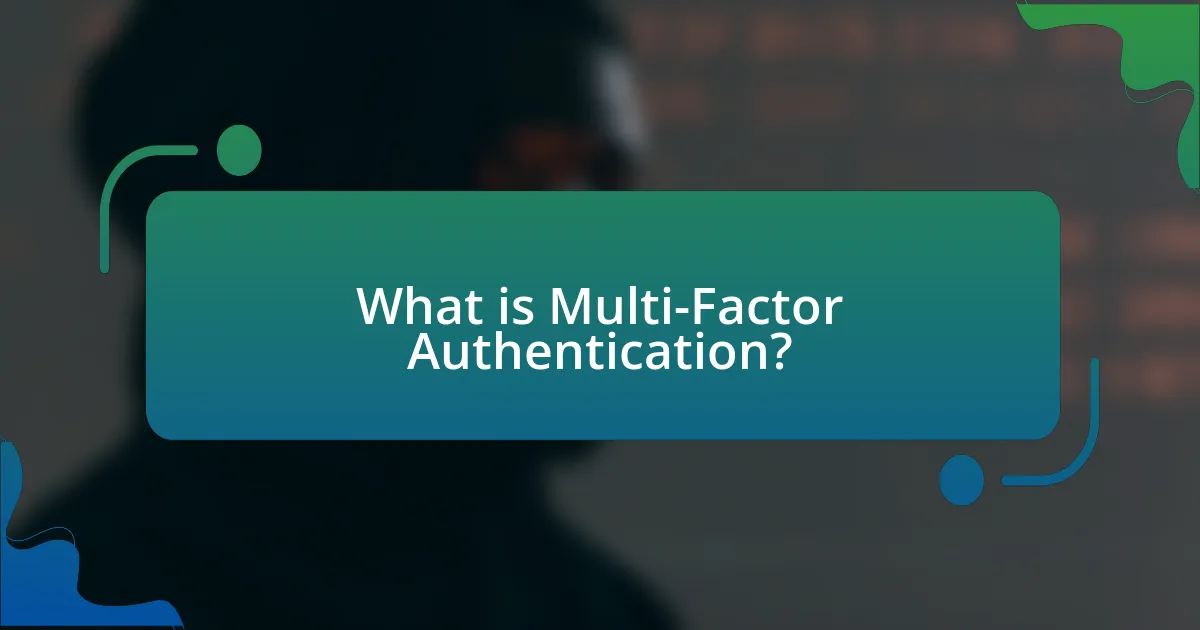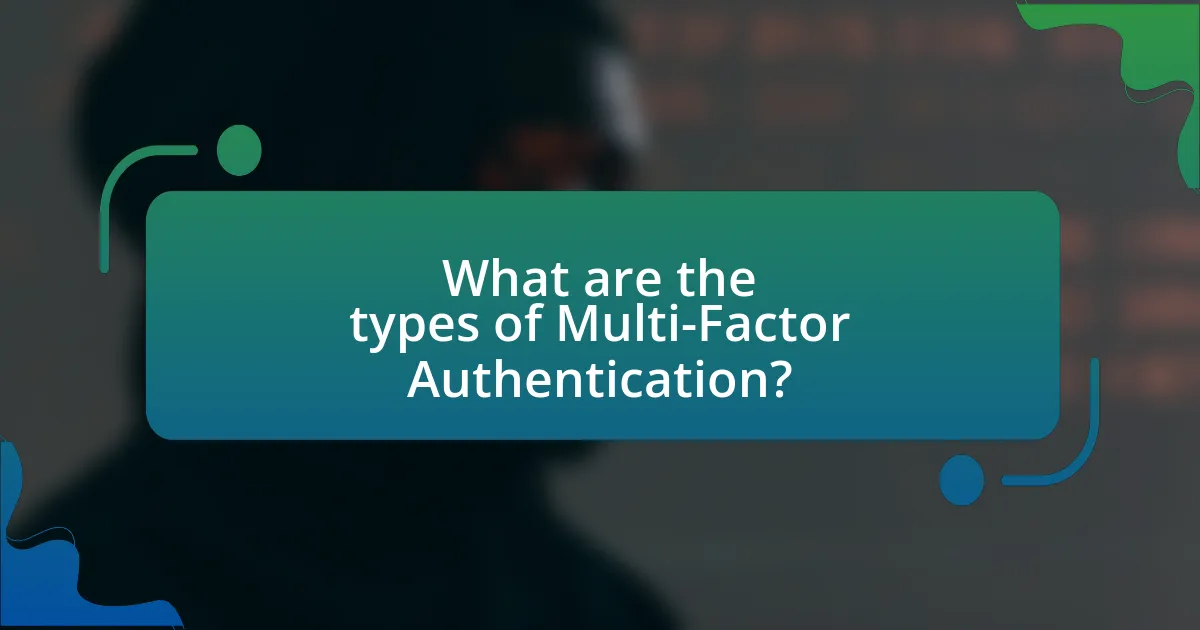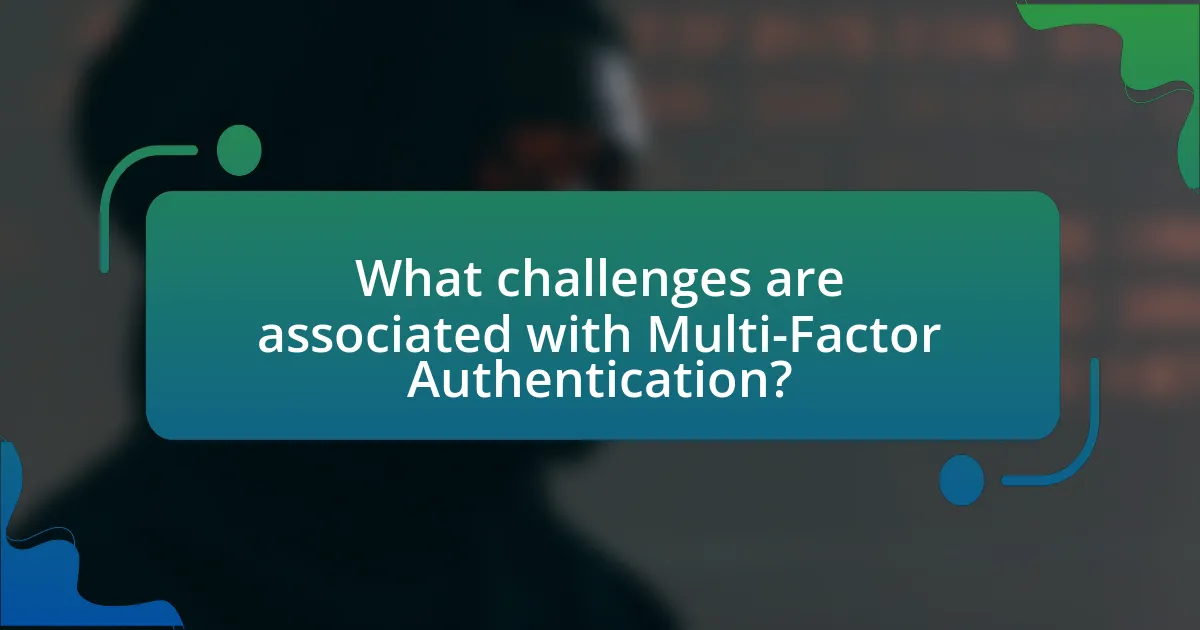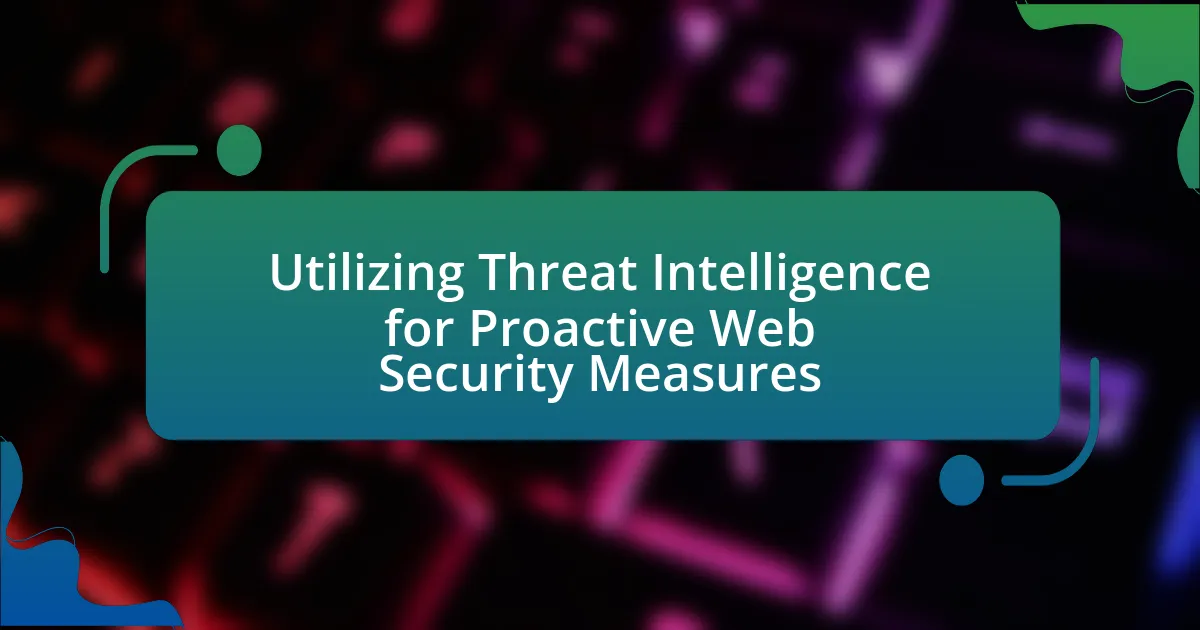Multi-Factor Authentication (MFA) is a critical security mechanism that requires users to provide multiple verification factors to access applications or online accounts, significantly enhancing web security. The article outlines how MFA combines knowledge-based, possession-based, and inherence-based factors to mitigate risks associated with unauthorized access and cyberattacks. It discusses the effectiveness of MFA in various industries, including finance and healthcare, and highlights the challenges and user concerns related to its implementation. Additionally, the article explores future trends in MFA, such as the adoption of biometric verification and artificial intelligence, emphasizing the importance of user education and best practices for successful deployment.

What is Multi-Factor Authentication?
Multi-Factor Authentication (MFA) is a security mechanism that requires users to provide two or more verification factors to gain access to a resource, such as an application or online account. This method enhances security by combining something the user knows (like a password), something the user has (like a smartphone or hardware token), and something the user is (like a fingerprint or facial recognition). According to the Cybersecurity & Infrastructure Security Agency (CISA), MFA can significantly reduce the risk of unauthorized access, as it makes it more difficult for attackers to compromise accounts even if they have obtained a password.
How does Multi-Factor Authentication enhance web security?
Multi-Factor Authentication (MFA) enhances web security by requiring users to provide multiple forms of verification before gaining access to an account. This additional layer of security significantly reduces the risk of unauthorized access, as it is much harder for attackers to compromise multiple authentication factors simultaneously. For instance, a study by the Cybersecurity & Infrastructure Security Agency (CISA) found that MFA can block over 99% of automated cyberattacks, demonstrating its effectiveness in protecting sensitive information and accounts from breaches.
What are the different factors used in Multi-Factor Authentication?
Multi-Factor Authentication (MFA) utilizes three primary factors: something you know, something you have, and something you are. The first factor, “something you know,” typically refers to passwords or PINs that the user must enter. The second factor, “something you have,” involves physical devices such as smartphones or hardware tokens that generate time-sensitive codes. The third factor, “something you are,” encompasses biometric verification methods, including fingerprints, facial recognition, or iris scans. These factors collectively enhance security by requiring multiple forms of verification before granting access, significantly reducing the risk of unauthorized access.
How do these factors work together to improve security?
Multi-Factor Authentication (MFA) improves security by requiring multiple forms of verification before granting access to systems. This layered approach significantly reduces the risk of unauthorized access, as it combines something the user knows (like a password), something the user has (like a smartphone or hardware token), and something the user is (like biometric data). According to a study by Microsoft, MFA can block over 99.9% of account compromise attacks, demonstrating its effectiveness in enhancing security through the integration of diverse authentication factors.
Why is Multi-Factor Authentication important for users?
Multi-Factor Authentication (MFA) is important for users because it significantly enhances security by requiring multiple forms of verification before granting access to accounts. This additional layer of security reduces the risk of unauthorized access, as even if a password is compromised, an attacker would still need the second factor, such as a text message code or biometric verification, to gain entry. According to a study by Microsoft, MFA can block over 99.9% of automated attacks, demonstrating its effectiveness in protecting user accounts from breaches.
What risks does Multi-Factor Authentication mitigate?
Multi-Factor Authentication (MFA) mitigates risks associated with unauthorized access to accounts and sensitive information. By requiring multiple forms of verification, such as a password and a one-time code sent to a mobile device, MFA significantly reduces the likelihood of successful phishing attacks, credential theft, and brute-force attacks. According to a study by Microsoft, MFA can block over 99.9% of automated attacks, demonstrating its effectiveness in enhancing security against common threats.
How does Multi-Factor Authentication protect sensitive information?
Multi-Factor Authentication (MFA) protects sensitive information by requiring multiple forms of verification before granting access to an account. This process significantly reduces the risk of unauthorized access, as it combines something the user knows (like a password) with something the user has (like a smartphone for a one-time code) or something the user is (like a fingerprint). According to a report by the Cybersecurity & Infrastructure Security Agency, MFA can block over 99% of automated cyberattacks, demonstrating its effectiveness in safeguarding sensitive data against breaches.

What are the types of Multi-Factor Authentication?
The types of Multi-Factor Authentication (MFA) include knowledge-based factors, possession-based factors, and inherence-based factors. Knowledge-based factors require something the user knows, such as a password or PIN. Possession-based factors involve something the user has, like a smartphone or hardware token that generates a one-time code. Inherence-based factors rely on something the user is, which includes biometric verification methods such as fingerprints or facial recognition. These categories are widely recognized in cybersecurity frameworks, emphasizing the importance of combining multiple authentication methods to enhance security.
How do different types of Multi-Factor Authentication compare?
Different types of Multi-Factor Authentication (MFA) vary primarily in their methods of verifying user identity, which can include something the user knows (like a password), something the user has (like a smartphone or hardware token), and something the user is (like biometric data). For instance, SMS-based MFA sends a one-time code to the user’s phone, while app-based MFA generates a code within an authentication app, which is generally considered more secure due to reduced susceptibility to interception. Biometric MFA, such as fingerprint or facial recognition, offers a high level of security but may raise privacy concerns. According to a 2021 report by the Cybersecurity & Infrastructure Security Agency, implementing MFA can block over 99% of automated cyberattacks, highlighting the effectiveness of these various methods in enhancing security.
What are the advantages and disadvantages of SMS-based authentication?
SMS-based authentication offers advantages such as convenience and widespread accessibility, allowing users to receive one-time codes on their mobile devices quickly. This method is user-friendly, as it does not require additional hardware or software, making it easy for individuals to implement. However, disadvantages include vulnerability to interception through techniques like SIM swapping and phishing attacks, which can compromise security. Additionally, reliance on mobile networks means that users may face issues in areas with poor reception or during outages, potentially hindering access to accounts.
How does app-based authentication differ from hardware tokens?
App-based authentication differs from hardware tokens primarily in their form and functionality. App-based authentication utilizes software applications on smartphones or computers to generate time-sensitive codes or push notifications for user verification, while hardware tokens are physical devices that generate codes independently of any software. For instance, app-based solutions like Google Authenticator or Authy can provide a more flexible and user-friendly experience, as they can be easily installed and updated, whereas hardware tokens require physical possession and can be lost or damaged. This distinction highlights the convenience and accessibility of app-based authentication compared to the tangible nature and potential logistical challenges associated with hardware tokens.
What industries commonly implement Multi-Factor Authentication?
Industries that commonly implement Multi-Factor Authentication (MFA) include finance, healthcare, government, and technology. The finance industry utilizes MFA to protect sensitive financial data and transactions, as evidenced by regulations such as the Payment Card Industry Data Security Standard (PCI DSS) which mandates its use. In healthcare, MFA safeguards patient information in compliance with the Health Insurance Portability and Accountability Act (HIPAA). Government agencies adopt MFA to secure access to classified information and systems, reflecting the need for heightened security in public sector operations. The technology sector also employs MFA to protect user accounts and sensitive data, with many companies implementing it as a standard security measure to mitigate the risk of data breaches.
How does Multi-Factor Authentication benefit the financial sector?
Multi-Factor Authentication (MFA) significantly enhances security in the financial sector by requiring multiple forms of verification before granting access to sensitive information. This layered approach reduces the risk of unauthorized access, as it combines something the user knows (like a password) with something the user has (like a mobile device for a one-time code). According to a report by the Cybersecurity & Infrastructure Security Agency, MFA can block up to 99.9% of automated cyberattacks, highlighting its effectiveness in protecting financial institutions from fraud and data breaches. By implementing MFA, financial organizations can safeguard customer accounts and maintain trust, ultimately leading to a more secure banking environment.
What role does Multi-Factor Authentication play in healthcare security?
Multi-Factor Authentication (MFA) plays a critical role in healthcare security by significantly enhancing the protection of sensitive patient data and healthcare systems. MFA requires users to provide multiple forms of verification before gaining access, which reduces the risk of unauthorized access due to compromised passwords. According to a report by the Ponemon Institute, organizations that implement MFA can reduce the risk of data breaches by up to 99.9%. This is particularly vital in healthcare, where data breaches can lead to severe consequences, including identity theft and compromised patient safety. Therefore, MFA serves as a fundamental layer of security that helps safeguard healthcare information against evolving cyber threats.

What challenges are associated with Multi-Factor Authentication?
Multi-Factor Authentication (MFA) faces several challenges, including user resistance, implementation complexity, and potential security vulnerabilities. User resistance often stems from the perception that MFA adds inconvenience to the login process, leading to lower adoption rates. Implementation complexity arises from the need for organizations to integrate MFA into existing systems, which can require significant technical resources and expertise. Additionally, security vulnerabilities can occur if the second factor, such as SMS codes, is intercepted or if users fall victim to phishing attacks, undermining the effectiveness of MFA. These challenges highlight the need for careful planning and user education to ensure successful MFA deployment.
What are common user concerns regarding Multi-Factor Authentication?
Common user concerns regarding Multi-Factor Authentication (MFA) include usability, security, and privacy issues. Users often find MFA cumbersome due to the additional steps required for authentication, which can lead to frustration and potential abandonment of secure practices. Security concerns arise from the fear that MFA methods, such as SMS codes, can be intercepted or compromised, undermining the intended protection. Additionally, users worry about privacy implications, particularly when personal information is required for authentication, leading to anxiety about data misuse. According to a 2021 survey by the Ponemon Institute, 60% of users expressed concerns about the complexity of MFA processes, while 45% feared that their personal data could be exposed during authentication.
How can usability issues affect the adoption of Multi-Factor Authentication?
Usability issues can significantly hinder the adoption of Multi-Factor Authentication (MFA) by creating barriers that frustrate users and discourage them from implementing this security measure. When MFA processes are overly complex, time-consuming, or confusing, users may perceive them as inconvenient, leading to resistance against adopting MFA solutions. For instance, a study by the National Institute of Standards and Technology (NIST) found that user frustration with complicated authentication processes can result in users opting for less secure methods, thereby undermining the intended security benefits of MFA. This highlights that improving usability is crucial for enhancing user acceptance and ensuring the effectiveness of Multi-Factor Authentication in protecting sensitive information.
What are the potential security vulnerabilities in Multi-Factor Authentication systems?
Multi-Factor Authentication (MFA) systems can be vulnerable to several security risks, including phishing attacks, SIM swapping, and man-in-the-middle attacks. Phishing attacks can trick users into providing their authentication codes, undermining the security MFA is designed to provide. SIM swapping allows attackers to take control of a user’s phone number, intercepting SMS-based authentication codes. Man-in-the-middle attacks can capture authentication data during transmission, compromising the integrity of the authentication process. These vulnerabilities highlight that while MFA enhances security, it is not infallible and can be exploited if users are not vigilant.
How can organizations effectively implement Multi-Factor Authentication?
Organizations can effectively implement Multi-Factor Authentication (MFA) by integrating it into their existing security protocols and ensuring user compliance. This involves selecting appropriate authentication methods, such as SMS codes, authenticator apps, or biometric verification, and configuring them to work seamlessly with current systems. According to a report by the Cybersecurity & Infrastructure Security Agency (CISA), implementing MFA can reduce the risk of unauthorized access by up to 99.9%. Additionally, organizations should provide training to employees on the importance of MFA and how to use it properly, as user awareness is critical for successful adoption. Regularly reviewing and updating MFA policies ensures that they remain effective against evolving threats.
What best practices should organizations follow for successful implementation?
Organizations should follow several best practices for the successful implementation of multi-factor authentication (MFA). First, they must conduct a thorough risk assessment to identify sensitive data and systems that require MFA, ensuring that the most critical assets are protected. Second, organizations should choose an MFA solution that integrates seamlessly with existing systems and applications, enhancing user experience while maintaining security. Third, they need to provide comprehensive training for employees on the importance of MFA and how to use it effectively, as user compliance is crucial for the success of any security measure.
Additionally, organizations should regularly review and update their MFA policies to adapt to evolving threats and technological advancements. According to a report by the Cybersecurity & Infrastructure Security Agency (CISA), implementing MFA can block up to 99.9% of automated cyberattacks, highlighting the effectiveness of these practices in enhancing security.
How can organizations educate users about Multi-Factor Authentication?
Organizations can educate users about Multi-Factor Authentication (MFA) by implementing comprehensive training programs that include workshops, online tutorials, and informational resources. These educational initiatives should focus on explaining the importance of MFA in enhancing security, detailing how it works, and providing step-by-step guidance on setting it up. For instance, a study by the Cybersecurity & Infrastructure Security Agency (CISA) indicates that organizations that provide user training on MFA see a significant reduction in security breaches, highlighting the effectiveness of education in promoting secure practices.
What are the future trends in Multi-Factor Authentication?
Future trends in Multi-Factor Authentication (MFA) include the increased adoption of biometric authentication, the integration of artificial intelligence for risk-based authentication, and the shift towards passwordless solutions. Biometric methods, such as facial recognition and fingerprint scanning, are gaining popularity due to their convenience and security, with a report from MarketsandMarkets projecting the biometric market to reach $59.31 billion by 2025. AI-driven risk-based authentication enhances security by analyzing user behavior and context to determine the necessity of additional verification steps, as evidenced by a study from Gartner indicating that 60% of organizations will implement AI in their security protocols by 2024. Additionally, the move towards passwordless authentication, utilizing methods like one-time codes and hardware tokens, is supported by the FIDO Alliance, which aims to eliminate passwords entirely, reflecting a growing trend towards more secure and user-friendly authentication methods.
How is technology evolving to enhance Multi-Factor Authentication?
Technology is evolving to enhance Multi-Factor Authentication (MFA) through the integration of biometric verification, adaptive authentication, and the use of artificial intelligence. Biometric verification, such as fingerprint and facial recognition, provides a unique and secure method of identity verification, reducing reliance on traditional passwords. Adaptive authentication analyzes user behavior and context, adjusting security measures based on risk levels, which improves user experience while maintaining security. Additionally, artificial intelligence is being utilized to detect anomalies and potential threats in real-time, further strengthening MFA systems. These advancements collectively contribute to a more robust and user-friendly authentication process, addressing the increasing sophistication of cyber threats.
What role will biometrics play in the future of Multi-Factor Authentication?
Biometrics will play a crucial role in the future of Multi-Factor Authentication (MFA) by enhancing security through unique physical characteristics. As cyber threats evolve, traditional authentication methods like passwords become increasingly vulnerable; therefore, integrating biometrics—such as fingerprint recognition, facial recognition, and iris scanning—provides a more secure layer of identity verification. According to a report by the International Data Corporation, the global biometrics market is expected to reach $38.5 billion by 2025, indicating a significant shift towards biometric solutions in security protocols. This trend underscores the importance of biometrics in creating a more robust MFA framework, ultimately reducing the risk of unauthorized access and identity theft.
What practical tips can enhance the effectiveness of Multi-Factor Authentication?
Implementing strong, unique passwords alongside Multi-Factor Authentication (MFA) significantly enhances its effectiveness. Strong passwords reduce the risk of unauthorized access, while MFA adds an additional layer of security. According to a study by Google, using MFA can block 100% of automated bots and 96% of bulk phishing attacks. Regularly updating authentication methods, such as using time-based one-time passwords (TOTP) or biometric verification, further strengthens security. Additionally, educating users about recognizing phishing attempts ensures they do not inadvertently compromise their MFA credentials.




